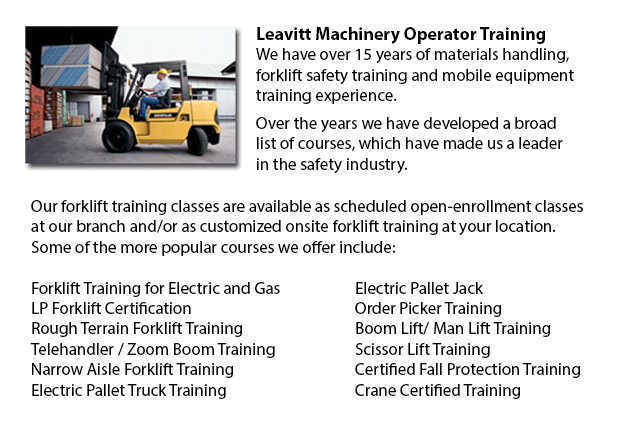
Hyster Forklift Training British Columbia - Hyster is now a world leader in forklifts along with warehousing solutions. However, it began as a producer of lifting machinery as well as winches. Most of its production was concentrated in the northwest United States and dealt mostly with the timber and logging industry. A couple years after the first forklift trucks were invented Hyster became synonymous with quality production. Over the previous 80 years Hyster has continued to get bigger and develop its product line. The expansion of its products coupled with its desire to stay service oriented has allowed Hyster to grow into the international player it is nowadays.
In the period between 1940 and 1960, Hyster continued its progress throughout the western world. In 1946, Hyster opened a plant in Illinois that was fully devoted to mass manufacturing trucks. This allowed Hyster to drive its expenses down and, at the same time, offer a better quality product at industry competitive prices. In 1952, Hyster began its first foray in to the international production market through opening its first plant in the Netherlands. The Netherlands plant was originally designed to produce two products: Hyster 40" and the Karry Kranes.
Hyster, along with the whole forklift industry, continued to spread out into different product lines throughout the 1950's and 60's. They began constructing container handlers in the United states in 1959 to satisfy the ever growing demand for transportation goods. In 1966, Hyster developed a means for enabling a lift truck to go both ahead and backwards using the same pedal. This pedal was termed the Monotrol pedal, which revolutionized the industry. Later in the decade Hyster opened a R and D centre in Oregon that was concentrated on improving the design and performance of lift trucks. The centre is still one of the world's greatest testing facilities in the materials handling industry.
As demand for materials handling equipment continued to expand rapidly during the sixties, Hyster needed to reorient its focus towards these new mass markets. Consequently, in 1970, the XL design philosophy was born. The XL design philosophy allowed Hyster to provide greater quality at a more reasonable cost. A further expansion in manufacturing capabilities was necessitated by the demand in Europe for Internal Combustion Engine Trucks. To fill this hole, a plant in Craigavon, Ireland was opened in 1980. Through the eighties Hyster continued to focus on developing industry leading forklifts. The Hyster brand name was known throughout the world for its dedication towards quality. This attention to quality brought a lot of suitors for the business. In 1989, a large international business based in Ohio called NACCO Industries purchased Hyster and began an aggressive expansion plan. NACCO promptly replaced the XL philosophy with a more driver oriented truck that concentrated on operator comfort, which is recognized as the XM generation of lift trucks.
The evolving needs of Hyster's consumers, led by improvements in supply chain management, required Hyster to continuously innovate and invest in modern manufacturing technology throughout the next few decades. Acquisitions and investments were made in the United States, Italy, Netherlands, and lots of other places all over the globe. All of these investments have made Hyster a worldwide leader in the forklift market. In 2009, Hyster celebrated its eightieth anniversary as an industry leader of materials handling equipment, which comprises more than three hundred various versions of lift trucks.
-
Scissor Pallet Trucks
Scissor Pallet Truck Training British Columbia - Scissor pallet lift trucks are built for moving and hauling separately stacked pallets by integrating a raising mechanism that permits the pallets on the vehicle to be elevated. This apparatus is a fir... More -
Toyota Forklift
Toyota Forklift Training British Columbia - Since 1992, Toyota Material Handling inc., U.S.A., often known as TMHU, continues to be the best selling lift truck provider in the United States. This business has been based out of Irvine, California for... More -
Komatsu Forklift
Komatsu Forklift Training British Columbia - Komatsu Forklift U.S.A. Inc. has a very good reputation for building dependable and robust forklifts. Komatsu is recognized around the world as a corporation with a rich heritage while preserving an except... More -
Boom Lifts
Boom Lifts Training British Columbia - Boom lifts are equipment that has a platform that may be lowered or raised to many heights, thus making this piece of equipment an important necessity in a wide variety of professions. Offered in quite a few par... More -
Rough Terrain Forklifts
Rough Terrain Forklifts Training British Columbia - There are in fact two different classifications of forklifts within the material handling market, the industrial model and the rough terrain model. Rough terrain lift trucks first arrived on the mar... More

Forklift Training British Columbia
TOLL FREE: 1-888-254-6157
forklifttrainingbritishcolumbia.com
Email Us
About Us


